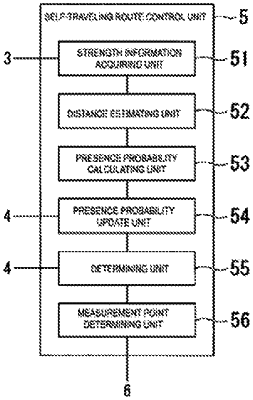| CPC G01S 5/0278 (2013.01) [G01S 5/02 (2013.01); G01S 5/0215 (2013.01); G06T 7/246 (2017.01); H04B 17/27 (2015.01); H04B 17/345 (2015.01); G01S 5/011 (2020.05); G06T 2207/30192 (2013.01)] | 8 Claims |

|
1. An interference source hunting method of hunting for a location of an interference source of electromagnetic waves while moving between multiple measurement points, the multiple measurement points being predetermined positions in a hunting-target area, the interference source hunting method comprising:
a strength information acquiring step of acquiring strength information indicating a strength of the electromagnetic waves at any of the measurement points;
a distance estimating step of estimating a distance from the measurement point to the location of the interference source, based on the strength information and propagation losses;
a presence probability calculating step of calculating, for each position in the hunting-target area, a first presence probability, based on whether a distance from the measurement point to a position in the hunting-target area is within the distance thus estimated, the first presence probability being a probability that the interference source is present at the position;
a presence probability update step of updating second presence probabilities, based on the first presence probabilities, the second presence probabilities being acquired in the hunting in past and being probabilities that the interference source is present at the positions in the hunting-target;
a measurement point determining step of determining a position obtained by moving, by a predetermined distance, the measurement point toward a position in the hunting-target area with the second presence probability higher than the second presence probability at the measurement point, as a new measurement point; and
a determining step of determining, in a case where a size of an area based on positions each with the second presence probability thus updated greater than or equal to a predetermined value is less than a predetermined value, that the location of the interference source is within the area.
|